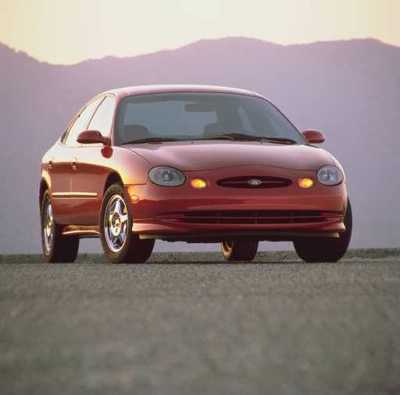New Car/Review- 1996/1997 FORD TAURUS SHO
by Tom Hagin
SEE ALSO: Ford Buyer's Guide
SPECIFICATIONS
Manufacturer's Suggested Retail Price $ 25,930*
Price As Tested $ 29,690*
Engine Type 3.4 Liter V8 w/SFI**
Engine Size a 207 cid/3390 cc
Horsepower 230 @ 6000 RPM
Torque (lb-ft) 225 @ 4800 RPM
Wheelbase/Width/Length 108.5"/73.0"/197.5"
Transmission Four-speed automatic
Curb Weight 3379 Pounds
Fuel Capacity 16.0 gallons
Tires (F/R) P225/55VR16
Brakes (F/R) Disc (ABS)/disc (ABS)
Drive Train Front-engine/front-wheel-drive
Vehicle Type Five-passenger/four-door
Domestic Content N/A
Coefficient of Drag (Cd.) 0.30
PERFORMANCE
EPA Economy, miles per gallon
city/highway/average 17/26/23
0-60 MPH 8.2 seconds
1/4 Mile (E.T.) 16.4 seconds @ 86.7 mph
Top-speed 139 mph
* Price for 1996 model
** Sequential fuel injection
If the Ford Taurus is the archetypal American family sedan, the Taurus SHO is that family's overachiever. Appearing first in 1989, the SHO was Ford's answer the high-performance sedans coming from Europe and Japan. It was soon obvious that while fast, that first SHO was fragile and it's V6 engine wasn't up to the image Ford wanted to project.
That problem has been rectified in the latest version. There's now two more cylinders under the hood, and the troublesome five-speed manual transmission has been dropped. With these changes, Ford hopes that smoothing the rough edges of the SHO will re-arouse enthusiasts.
OUTSIDE - The Taurus ovoid design was almost universally panned as being too much for the general public to digest. But benefits in aerodynamics and reducing wind noise have proven effective. Subtle, but significant changes differentiate SHO and plebeian Tauruses. Up front, a larger grille opening, along with a second port below the bumper line allow more fresh air to reach the engine bay for better cooling. In back, a small rear spoiler rides on the trunk lid, and the rear fascia is unique to SHO. Also, the lower rocker panels are flared, which gives it a lower, wider, performance-oriented identity. It rides on 16-inch aluminum wheels, (optionally chromed) and Goodyear performance tires.
INSIDE - Behind the wheel of the SHO, the family sedan influence is obvious. Aside from its SHO-specific 150-mph speedometer, most of the interior is common to the Taurus lineup. All models share the same swoopy interior, with organic shapes and highly sculpted forms. And where the front bucket seats of the old SHO enjoyed lots of side bolstering, the new model's chairs are seemingly made to fit a broader array of physiques. There is plenty of leg and headroom to adequately fit four adults, though five can be accommodated in a pinch. Because of Taurus's new shape, which radically rounds the roof line, some headroom fore and aft inside the cabin has been sacrificed. Our test car came fully loaded, and as part of an optional preferred equipment package, it was equipped with keyless remote entry, automatic air conditioning, a power moonroof, and a high-powered JBL-brand stereo system.
ON THE ROAD - The original SHO, with its Yamaha-modified twin-cam V6, packed muscle under the hood of what was essentially a family sedan. The Japanese company is in on the new 3.4 liter V8 as well. It receives the bare castings from Ford's Windsor, Ontario plant, machines and assembles the powerplant, then ships them to Ford in Atlanta for installation. It is a marvel of compactness, and also features such innovations as reverse-flow cooling, where the cylinder heads receive coolant before the engine block, and coil-on-plug ignition, which improves cold starts and emissions. With many parts shared with Ford's Duratec V6, the new engine produces 235 horsepower and 230 lb-ft of torque. Power delivery is smooth and responsive, and upon entering freeway traffic, the SHO leaps quickly to speed. The sole transmission, an electronically-controlled four-speed automatic, shifts predictably, even at full throttle.
BEHIND THE WHEEL - The SHO's suspension is relatively simple, with struts, coil springs and anti-roll bars front and rear. Also at work in the SHO's chassis are "reactive" shock absorbers that take information from a microprocessor to effectively limit body roll, acceleration "squat," and braking "dive." Since the current generation Taurus is more rigid than the older version, by adding SHO components, the family car attitude fades. It remains flat in corners, exhibits very little tire scrub, yet rides well during normal driving. The new SHO also benefits from rack-and-pinion steering with special components to enhance on-center feel and precision. Braking is accomplished by four-wheel discs that have been enlarged over the previous version, and an anti-lock system is used on each wheel.
SAFETY - Dual airbags, anti-lock brakes and side-impact protection are standard on Taurus SHO.
OPTIONS - The preferred equipment package adds $1,855, the six-disc CD changer is $595, while leather seats add $1,190.



